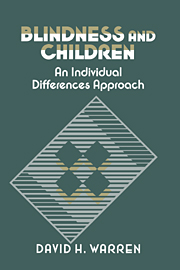Book contents
- Frontmatter
- Contents
- Preface
- Introduction
- Part I Interaction with the physical world
- 1 Perception of the physical world
- 2 Motor and locomotor interaction with the physical world
- 3 Understanding the physical world
- 4 Spatial understanding and spatial behavior
- Part II The acquisition of cognitive skills
- Part III Adapting to the social world
- Part IV Summary
- Conclusion
- References
- Author index
- Subject index
1 - Perception of the physical world
from Part I - Interaction with the physical world
Published online by Cambridge University Press: 02 December 2009
- Frontmatter
- Contents
- Preface
- Introduction
- Part I Interaction with the physical world
- 1 Perception of the physical world
- 2 Motor and locomotor interaction with the physical world
- 3 Understanding the physical world
- 4 Spatial understanding and spatial behavior
- Part II The acquisition of cognitive skills
- Part III Adapting to the social world
- Part IV Summary
- Conclusion
- References
- Author index
- Subject index
Summary
The mediating role of perception in human behavior is vast, and this is particularly true in issues of development. Perceptual information, acquired via the senses, serves the direct function of mediating physical interaction with the environment by manual and locomotor behaviors. Only slightly less directly, perceptual information is the basis for the child's learning about and acquiring a conceptual understanding of the properties of the physical world. Because of the pervasive involvement of perception in other areas of development, it is useful to treat this topic first. We will start with perceptual development in infancy and then move to issues of perception in older children.
Perceptual development in infancy
The past several decades have seen tremendous growth in our knowledge about the perceptual capabilities of the neonate and young infant. Generally, the more we learn, the more we come to be impressed with the infant's capabilities. Not surprisingly, the bulk of research attention has been devoted to the development of visual perception, from the anatomical basics such as visual acuity and lens accommodation to capabilities that show integration of immediate sensory information with previous experience, such as the perception of pattern or distance relationships. Auditory perception has not been neglected, however, and we have good information about the neonate's and young infant's ability to make basic auditory discriminations of amplitude and pitch, and about more complex types of auditory perception such as speech sounds and spatial localization.
Although there is much less research with infants with visual impairments, there is nevertheless sufficient information available about the basic perceptual abilities to draw important conclusions.
- Type
- Chapter
- Information
- Blindness and ChildrenAn Individual Differences Approach, pp. 12 - 29Publisher: Cambridge University PressPrint publication year: 1994
- 1
- Cited by



